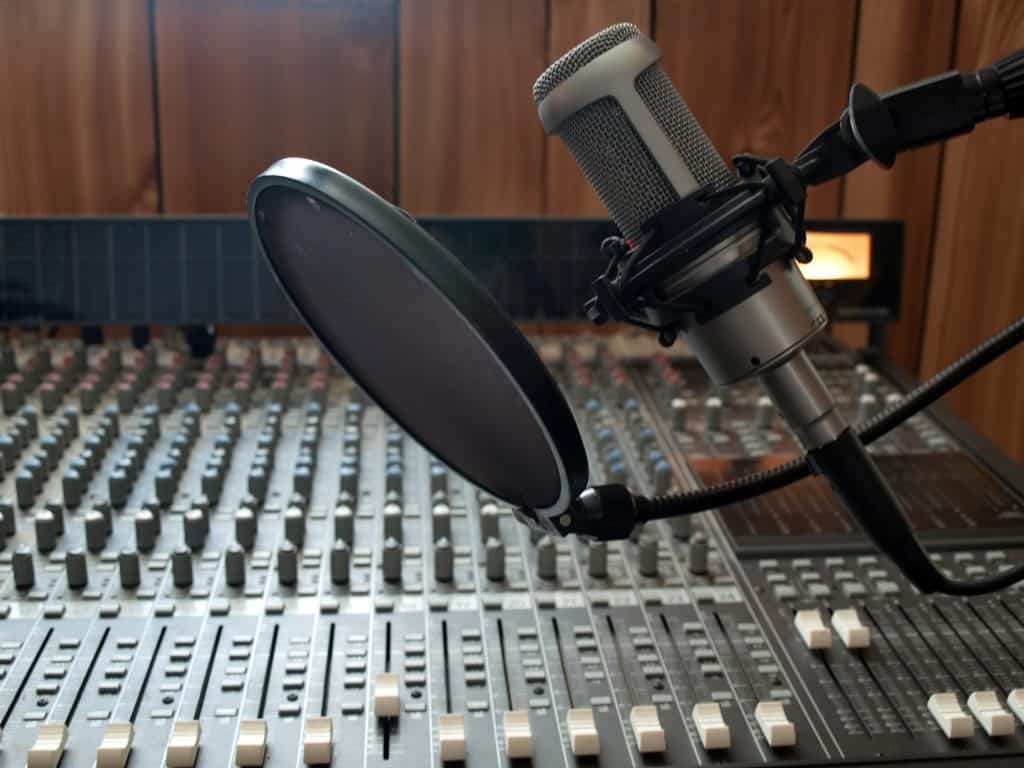An audiobook business is a great way to have a better work/life balance so that you can spend more time with your family and friends.
If you are an author or narrator interested in creating an audiobook business, below are three types of publishing businesses that allow you to determine the amount of creative work you would like to contribute.
- Audiobook Business – The owner outsources creating the ebook, paperback book, and audiobook but coordinates each step of the business process.
- Narrator Audiobook Business – The owner uses public domain books to create the ebook and paperback books but creates the audiobook in a home studio.
- Author Audiobook Business – The owner creates the ebook, paperback book, and audiobook and relies on Amazon and Audible for distribution.
How much does it cost to start an audiobook business?
It depends on the amount of creative work you, as the owner, want to put into the business. Below you’ll find three broad categories of audiobook businesses and their related costs.
| Business Steps | Audiobook Business Costs | Narrator Audiobook Business Costs | Author Audiobook Business Costs |
| Book Niche | Free | Free | Free |
| Book Outline | Free | N/A | Free |
| Book Writing | N/A | N/A | Free |
| Ghost Writer | $600 | N/A | N/A |
| Public Domain Books | N/A | Free* | N/A |
| Cover Art | $20 | $20 | $20 |
| Book Marketing | Free | Free | Free |
| Editor | $250 | $250 | $250 |
| Book Formatting | $20 | $20 | $20 |
| ACX Audiobook Recording | $360 | N/A | N/A |
| Home Recording Studio | N/A | $425** | N/A |
| Home Audiobook Recording | N/A | Free | N/A |
| Audiobook Marketing | Free | Free | Free |
| Total Cost | $1250 | $290** | $290 |
* If you choose to add images to your public domain book, you could spend from $10 to $100.
** If you create a home studio, you’ll only pay for equipment once.
The rest of this article goes into detail about these three types of audiobook businesses. You find some analysis about ebook and paperback book creation, book marketing, audiobook recording, audiobook marketing, and more.

Audiobook Business
In this option, you’re the conductor of an orchestra. The orchestra is your publishing business, and your job as the conductor is to make sure all of the pieces work together.
What are the publishing steps?
Before you can create an audiobook, you need an ebook and paperback book. Once your book is ready, you’ll need to hire a narrator who fits well into the book’s genre. Your next step is to distribute and market your ebook, paperback book, and audiobook. Even though I’ve listed marketing last, in reality, marketing takes place throughout the publishing process.
Book Niche
Amazon
Before you create your ebook and paperback book, you need to figure out your book’s niche. As the publisher, you’ll need to start with market research. Look for niches that show lower competition and high search volume. Of course, this is much easier said than done!
Amazon has a sizable chuck of the ebook market. Therefore, it’s safe to start your research on this platform. Amazon doesn’t release its search volume, but there are several apps that can estimate the demand for a particular niche by using Amazons Best Seller Rank (BSR). In its Kindle store or Book store, Amazon ranks all of its ebooks or paperback books by how often they sell. The ebook that sells the most will get a ranking of #1 and the one that sells the least will get a ranking into the millions.
KDSpy is a Chrome extension that helps you figure out which niches have lower BSRs. If you go to Amazon and type a niche into the search bar, the page will list the results of your niche.
How do you find a niche?
To get started, you choose a general topic that interests you. For example, you could type “cozy mysteries” into the search bar on the Amazon website. The search results are over 40,000. The average BSR, from KDSpy, is over 84,000.
This is a case where the BSR is very good because it’s closer to #1 than a million. However, the competition (the number of search results) is too high. This is easy to fix by narrowing the search term.
To continue, you choose a narrower niche within your original search term. For example, you could type in “cozy mysteries cats”.
How did I know to choose that search term?
I typed in “cozy mysteries a”, “cozy mysteries b”, and “cozy mysteries c”. I waited for Amazon’s search bar to autocomplete. When the search options show something interesting to me, I select that term. In this case, the search option was “cozy mysteries cats”.
Note that the search options are terms that other readers have used in the past. This is key because now you know this is a desired book.
In fact, KDSpy reports that the average BSR is just over 72,000 and the search results are just over 6000. These results are excellent because there are only 6000 other books instead of the original 40,000 books. If you wanted to create books in this genre, you could go ahead and get started.
Audible
In addition to Amazon, you’ll need to check your BSR on Audible. Audible is the audiobook store for Amazon. When you’re a publisher you’ll want to produce books in all available formats so that you can attract more readers.
Start with the niche you used on Amazon, but be careful because you want to wait for the autofill in the search bar. Many times the search phrases used on Amazon aren’t the same on Audible.
One more thing, KDSpy doesn’t work on Audible, thus you’ll need to do this research manually.
Start by typing in the search phrase “cozy mysteries”. The search results are over 4,000 audiobooks. This is quite a bit of competition. However, just to make sure, check the number of reviews. If all of the audiobooks on the first page have 50 or more reviews, you’ll have trouble breaking into this niche.
To continue, choose a narrower niche. You could try “cozy mysteries cats”. The search results are 167. Also, on the first page, 12 out of 20 audiobooks have more than 50 reviews.
If you work on building a large email list, you could create a cat cozy mystery and make sure your fans leave 50 or more reviews. This will ensure that you rank on the first page for that search term.
Book Outline
As a publisher, you’ll outsource the writing of the ebook and paperback book. However, don’t contact a ghost writer and say, “write a cat cozy mystery, please.” You’ll just get back a load of junk.
Instead, take the time to read the top 5 – 10 books ranking on Amazon. You want to get a general idea of what happens in these books. That way you’ll know what types of elements to include in your book.
Use the books you have just read to decide what you want in Chapter 1, 2, and so on. You won’t copy any books, instead you’ll decide on important elements like:
- Who is the amateur sleuth?
- When does the dead body show up?
- What are the clues?
- What are the red herrings?
- Who is the villain?
Make your outline as detailed as possible. If it’s important to have a character with a particular characteristic, make sure you include that detail. Your ghost writer will create the words for your book, but it’s up to you to include the elements that your fans will love. That is another advantage of doing the research before you start on your outline.

Ghost Writer
There are several options for finding ghost writers such as Hot Ghost Writer, The Urban Writers, and eWriter Solutions. However, I’m going to use Fiverr.com for this example only because I’m familiar with them.
If you choose Fiverr.com, do not use the cheapest writer. You want a writer who is either a Top-Rated Seller or a Level 2 Seller. You can also choose a genre if it helps to narrow down the number of ghost writers.
How long should your book be?
Even though we are talking about an ebook or paperback book, the end goal is to create an audiobook. Let’s start by looking at the desired length of the audiobook, and then determine how long the ebook and paperback book need to be.
Audiobook Creation Exchange (ACX) is the audiobook production arm of Amazon. ACX works with Audible to create your audiobook and then place it in the online store.
Audible/ACX determines how much your audiobook will sell for depending on its length. The longer your audiobook, the more money you’ll make. If you would like to learn more about their pricing model, take a look at this ACX Pricing article.
Below is a list of the audiobook length and the range that Audible will charge a listener.
- under 1 hour: under $7
- 1 – 3 hours: $7 – $10
- 3 – 5 hours: $10 – $20
- 5 – 10 hours: $15 – $25
- 10 – 20 hours: $20 – $30
- over 20 hours: $25 – $35
Generally, a narrator speaks at a rate of 9300 words per hour. This means that a 1-hour audiobook should have about 9300 words. If you can get past 3 hours you’ll earn at least $10 per audiobook. However, your royalty will only be $4. If you would like to learn more about audiobook royalties, take a look at my article How Much Do Audiobook Narrators Make.
A 3-hour audiobook is just over 27,000 words. To ensure that the audiobook is 3 hours long, let’s round to 30,000 words. On Fiverr.com, this gig would cost from $300 to $1,000. The average price was around $600.
Cover Art
The last element of your ebook, paperback book, and audiobook you’ll need is the cover. Unless you’re a graphic designer, always outsource this step. This is the most important part of the book creation process! This cover is the reason your readers and listeners will stop and read your title. If they like your title, they’ll read your description, and purchase your book.
Earlier, you read five cozy mystery books. Go back to those books and take a look at the covers. Send the links of each of these books to your cover designer. In addition, let her know what you need on your cover that will reflect what your book is about.
Prices vary from $10 to $50. I deliberately don’t choose the $5 options because they are usually very new and don’t produce the best results. The average price is around $20.
I also recommend that you spend a little more money and have your cover designer make a cover for all formats (ebook, paperback book, and audiobook).

Book Marketing
Once you send your outline to a ghost writer, you’ll have to wait a few weeks. During this time, you should continue marketing. The purpose of this marketing is to grow your email list. You’ll need this email list to leave reviews for your ebook, paperback book, and audiobook.
To engage you subscribers, you can hold contests. You could have additional images made of the world you’re creating and show that to your subscribers. You could have your subscribers vote on cover art.
In the previous step, you had a designer create some cover art. You could create a gig with three or more cover designers. Then, you could ask your email list which cover they prefer. You may be surprised at the results. Many authors have stated that the cover they liked the best wasn’t chosen by their readers.
If you would like more information about staying in contact with your fans, take a look at my article, How to Launch an Audiobook.
In addition, you should use your favorite social media platform to continue to engage with your fans and collect email address. For example, when I write a story, it’s incredibly helpful to have an image in my mind of the main characters in my novel.
I go to a stock photo website and purchase an image that is as close as possible to the image I have of my main characters. You could use this time to start dribbling these images out to your email list with a short backstory.
Your email subscribers will love getting this inside information. In addition, you can use your social media platform to tease this information to potential subscribers.
If you would like to learn more about choosing a social media platform and engaging with your fans, take a look at my article Do Authors Need Social Media?
Editor
Once you get the manuscript from the ghost writer, read it over carefully. Also, check to make sure there is no plagiarized material. If you have a good ghost writer, you shouldn’t have a problem with this, but check anyway. If the manuscript meets your criteria based on the five books you read earlier, send the manuscript to an editor.
Why do you need an editor?
Your ghost writer will already have spent time editing their own work. However, nobody can catch all of their own mistakes. In fact, you’ll want a copy editor who checks each line of your manuscript. This editor checks for grammatical mistakes as well as any strange sentences that are incorrect or could be stated more clearly.
You should also use a proofreader who does a more detailed check of your manuscript for consistency. For example, my proofreader caught the fact that I used dashes inconsistently and incorrectly in a book I wrote a few years ago. I would have never seen that mistake.
A quick check of Fiverr.com showed that editor gigs for books around 30,000 words ranged from $180 to $350. I deliberately choose freelancers who were rated Level 1 or above. The average gig was around $250.
Book Formatting
Once you’re happy with the edited version of your manuscript, you’ll need to have it formatted. The purpose of this step is to get your ebook and paperback book in the proper format for Amazon. The ebooks are in a mobi format while the paperback books will be in a pdf format. In addition, a good formatter can add drop caps at the start of each chapter, change all chapter headings to start in the middle of the page, and more.
It’s possible to format your ebook and paperback book yourself. However, I have wasted days trying to fix formatting issues. They range from changing the position of an image to altering the font on some of the text. In the end, I learned it was better to outsource the formatting.
On Fiverr, most of the gigs varied from $5 to $40. I don’t recommend going with the $5 gig because these are usually new sellers. If you have something a little complicated inside your ebook, like images or bulleted lists, choose a gig around $40. If you have an all text manuscript, go with the $20 gigs.
Once you have the ebook and paperback book in the correct format, upload it to Amazon’s Kindle Direct Publishing. Carefully check every page of your upload to make sure it’s exactly as you want it. Every once in a while, I’ve had a problem with errors in the mobi file.

ACX Audiobook Recording
After your ebook and paperback book show up in the Amazon store, log into ACX.com and select your book. Follow the steps for audiobook creation which include:
- Verify you have audiobook rights
- Upload or verify your audiobook’s metadata like title, author name, copyright, etc.
- Select several narrators
- Review the auditions
- Select your narrator
- Wait for the first 15 minutes of your audiobook and verify it sounds the way you want
- Approve the final audiobook
- Distribute it to ACX/Audible’s network
- Promote your audiobook to your fans
If you would like more detail about publishing audiobooks on Audible/ACX, take a look at my article How to Publish an Audiobook on iTunes.
How much does a narrator cost?
Generally, for a 30,000-word book, the length of the audiobook will be around three hours. Narrators charge per finished hour (PFH) which refers to the length of the competed audiobook.
A less experienced narrator may charge $50 PFH which means you’ll pay $150 for the completed audiobook. An experienced narrator may charge $300 PFH which means you’ll pay $900. A decent narrator would be around $120 PFH which is $360 for the audiobook.
If you would like to learn more about how much to pay narrators and other royalty share options, take a look at my article How Much Do Audiobook Narrators Make?
Audiobook Marketing
While you’re waiting for the narrator to complete your audiobook, create your launch team. This team will be a subset of your email list. They join your launch team when they agree to listen to your audiobook and leave a review. They can also help promote your audiobook.
In return, you’ll need to give them an incentive like giveaways or group meetings or anything that your fans would find valuable. Take the time to continue to stay in touch with your launch team weekly as you approach your launch date.
If you would like more information about staying in contact with your fans, take a look at my article, How to Launch an Audiobook.
Also, continue to use social media to find new fans. On social media, you could post user images. For example, ask your fans to take pictures of themselves holding their favorite book. On the other hand, if you already have a released book, you could ask fans to take pictures while holding your book.
You could post the images on your website or on your favorite social media platform. Your goal is to get as many reviews as possible on or close to launch day.
If you would like to learn more about social media marketing, take a look at my article Do Authors Need Social Media?
Resources
The information on how to create an ebook, paperback book, and audiobook is available on YouTube University. In other words, I watched hundreds of hours of videos to understand and finally write my first books and create an audiobook.
The top-level ideas on running an audiobook business were inspired by Self-Publishing with Dale on this YouTube channel. I was also inspired by the Mikkelsen Twins on this YouTube channel, which is a collection of audiobook publishing ideas.

Narrator Audiobook Business
In this option, you follow some of the steps from the Audiobook Business (see the table at the beginning of this article). However, instead of using a ghost writer, you’ll use a public domain book. However, you’ll need to make some changes per Amazon’s terms of service.
The next steps are to follow some of the marketing steps from the Audiobook Business above. In addition, instead of using ACX to hire a narrator, you create your own home studio and start recording your audiobook. In the end, you follow the remaining steps from the Audiobook Business above.
Below is a list of the new steps for the Narrator Audiobook Business:
- Public Domain Books
- Home Recording Studio
- Audiobook Recording
Public Domain Books
Your first step is to choose a public domain book. It’s important that you start with the version of the book that doesn’t have a copyright. For example, if you want to create an audiobook about “Cinderella”, make sure you start with Charles Perrault’s “Cinderella”. Disney’s “Cinderella” is still under copyright.
It’s also important to pick a book that you like. You’ll be spending several months editing and eventually recording this book. You should enjoy the process.
There’s something you’ll need to keep in mind. Amazon won’t let you publish a public domain book unless you make substantial changes. Therefore, you’ll need to add a new introduction, images, study guide, author biography, or anything you think your fans would enjoy.
How much will all of this cost?
When you choose a book from the public domain, it’s free. If you add an introduction or a study guide, that’ll be free as well. However, if you want to add stock photos, you’ll need to pay a little. For example, Depositphotos.com charges $1 per image whereas iStockphoto.com charges about $10 per image. I have found that you get a lot more options at iStockphoto.com.
If you would like to learn more about working with public domain books, take a look at my article Recording Public Domain Audiobooks.
Home Recording Studio
Before you can record your audiobook, you need to set up your studio. Start by choosing a quiet place in your home. This needs to be a closet or small room that is far away from the refrigerator, furnace, air conditioner, and any home appliance that could make noise.
Once you decide on your recording space, you’ll need to treat it. By this, I mean you’ll need to add sound-dampening material on the walls and floor to reduce the echo in your recording space.
Your next and possibly most expensive step is purchasing recording equipment. Your list should include a good studio microphone with pop filter, studio headphones, a digital interface, recording software, and a computer.
If you already have a computer, then your microphone and interface will be the most expensive purchases for your studio. However, ACX has strict recording, editing, and mastering requirements. The better your recording space, the easier it will be to meet ACX’s recording requirements.
If you would like to learn more about creating an audio recording studio, take a look at my article Audiobook Recording Home Studio Tips.
Audiobook Recording
Audiobook recording includes narration, editing, proofing, and mastering. This process is usually done by the narrator on platforms such as ACX. If you’re planning to do the narration, you’ll also need to learn how to get your audio files to pass ACX’s recording requirements.
If you have never done narration before, then start slowly. You’ll need to start preparing about a week in advance. This preparation involves removing or decreasing caffeinated drinks, dairy, or anything else that may interfere with your vocal cords.
It’s important to get lots of sleep so that your voice remains in great condition during recording. Also, don’t go out to loud places where you’ll be required to raise your voice to be heard. You’ll want to do everything possible to pamper your voice.
If you’d like to learn more about preparing for narration, take a look at my article How Do You Prepare Your Voice Before Recording Your Audiobook?
In addition to preparing your voice, you’ll need to create an audiobook script. This is the script that gives directions such as where to put emphasis on a word, change your voice to accommodate different characters, and more. You could simply mark up the book or you could use software such as iAnnotate to keep track of your instructions.
If you would like to learn more about creating an audiobook script take a look at my article How Do You Write an Audiobook Script?
After you have narrated you audiobook, you’ll need to edit the audio files. This is the process of removing unwanted noises, altering the pacing of narration, and marking where you may need to rerecord. If you’re interested in audiobook editing, take a look at my article 19 Audiobook Editing Tips.
The next step after editing is proofing. This is where you check that the words you speak match the words in your book. This last check is good to perform before you master. If you would like to learn more about audiobook proofing, take a look at my article What is Audiobook Proofing?
The final step before you load your files to the ACX website is to master your audio files. This step involves noise reduction where you reduce background noise on your audio files. It also includes compression where you reduce the loud parts of your audiobook and increase the soft segments. This way you provide a uniform listening experience. The last step is normalization which limits the loud parts of your audiobook.
If you would like to learn more about audiobook mastering, take a look at my article, How to Master an Audiobook.
Once your files are ready, you can upload them to the ACX platform. These are the steps to upload your audio files:
- Open an Audible/ACX account or log on.
- Choose territories for distribution and the language of your audiobook.
- Verify that your audiobook meets Audible/ACX’s mastering requirements. Then agree to the audiobook license and distribution agreement.
- Enter your audiobook’s metadata such as author, description, title, copyright information, etc. Upload your audio files.
- Enter bank information for your future royalties.
References
I used YouTube University to learn how to write, publish, and market my ebooks, paperback books, and audiobook. However, it took a long time because I tried to do everything myself.
The additional steps in this part of my article were inspired by Karen Cummins. She wrote this wonderful article on how she launched her audiobook business, and it’s called How I Started My Audiobook Publishing Company.

Author Audiobook Business
In this option, you follow most of the steps of the Narrator Audiobook Business (see the table at the beginning of this article). However, instead of using a public domain book, you’ll write the book yourself. The rest of the steps are the same.
Book Writing
Instructions on how to write a book are beyond the scope of this article. Keep in mind that there are specific rules for writing fiction vs nonfiction. In addition, there are some pieces of information that are expected in your book depending on its niche or genre. Below are some important points that will apply:
Start with the book outline – The Audiobook Business step has more details on how to create an outline. I strongly suggest that you start with that outline. It’ll keep you focused on what needs to go into your book and help you create books that are marketable. This will make it easier to earn money.
Use dictation – Even a nonfiction book needs to be written in a friendly style to hold the reader’s interest. The best way to get this style into your book is to dictate it. I recommend “Fool Proof Outline” by Christopher Downing. It has comprehensive detail on how to set up your recording software, how to use your software properly, and what to expect as you record. I dictated an entire novel following the guidelines in this book.
Use writing sprints – If you really just don’t want to use dictation, I recommend writing sprints. This just means that you use a timer and you focus on writing for a set amount of time.
For example, if you want to write for 2 hours a day, you could write for 25 minutes, rest for 5 minutes, write for another 25 minutes and rest again for 5 minutes. You should continue until you reach 2 hours.
During your writing time, don’t check email, don’t answer your phone, and let your family know they can’t disturb you. Many authors finish books and novels in about a month with this method.
Conclusions
This article is meant for authors and narrators new to creating an audiobook business. There are several steps to this business, and you can do every one of them yourself or outsource everything.
Keep in mind some things really should be outsourced like editing the ebook and paperback book and creating a cover (unless you’re a graphic designer). I also don’t recommend formatting your book because it can cost you days trying to track down formatting errors.
Are you interested in starting an audiobook business? Which business model would you like to do? Let me know in the comments below.

